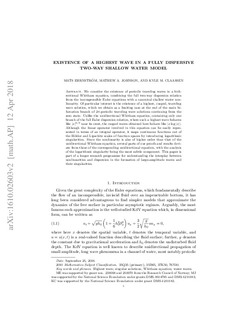| dc.contributor.author | Ehrnstrom, Mats | |
| dc.contributor.author | Johnson, Mathew A | |
| dc.contributor.author | Claassen, Kyle M | |
| dc.date.accessioned | 2019-01-16T07:38:47Z | |
| dc.date.available | 2019-01-16T07:38:47Z | |
| dc.date.created | 2018-11-22T10:46:15Z | |
| dc.date.issued | 2018 | |
| dc.identifier.citation | Archive for Rational Mechanics and Analysis. 2018, 1-39. | nb_NO |
| dc.identifier.issn | 0003-9527 | |
| dc.identifier.uri | http://hdl.handle.net/11250/2580780 | |
| dc.description.abstract | We consider the existence of periodic traveling waves in a bidirectional Whitham equation, combining the full two-way dispersion relation from the incompressible Euler equations with a canonical shallow water nonlinearity. Of particular interest is the existence of a highest, cusped, traveling wave solution, which we obtain as a limiting case at the end of the main bifurcation branch of 2π-periodic traveling wave solutions continuing from the zero state. Unlike the unidirectional Whitham equation, containing only one branch of the full Euler dispersion relation, where such a highest wave behaves like |x| 1/2 near its crest, the cusped waves obtained here behave like |x log |x||. Although the linear operator involved in this equation can be easily represented in terms of an integral operator, it maps continuous functions out of the H¨older and Lipschitz scales of function spaces by introducing logarithmic singularities. Since the nonlinearity is also of higher order than that of the unidirectional Whitham equation, several parts of our proofs and results deviate from those of the corresponding unidirectional equation, with the analysis of the logarithmic singularity being the most subtle component. This paper is part of a longer research programme for understanding the interplay between nonlinearities and dispersion in the formation of large-amplitude waves and their singularities. | nb_NO |
| dc.language.iso | eng | nb_NO |
| dc.publisher | Springer Verlag | nb_NO |
| dc.title | Existence of a Highest Wave in a Fully Dispersive Two-Way Shallow Water Model | nb_NO |
| dc.type | Journal article | nb_NO |
| dc.type | Peer reviewed | nb_NO |
| dc.description.version | acceptedVersion | nb_NO |
| dc.source.pagenumber | 1-39 | nb_NO |
| dc.source.journal | Archive for Rational Mechanics and Analysis | nb_NO |
| dc.identifier.doi | 10.1007/s00205-018-1306-5 | |
| dc.identifier.cristin | 1633638 | |
| dc.relation.project | Norges forskningsråd: 250070 | nb_NO |
| dc.relation.project | Norges forskningsråd: 231668 | nb_NO |
| dc.description.localcode | This is a post-peer-review, pre-copyedit version of an article published in [Archive for Rational Mechanics and Analysis] Locked until 7.9.2019 due to copyright restrictions. The final authenticated version is available online at: https://doi.org/10.1007/s00205-018-1306-5 | nb_NO |
| cristin.unitcode | 194,63,15,0 | |
| cristin.unitname | Institutt for matematiske fag | |
| cristin.ispublished | true | |
| cristin.fulltext | postprint | |
| cristin.qualitycode | 2 | |
